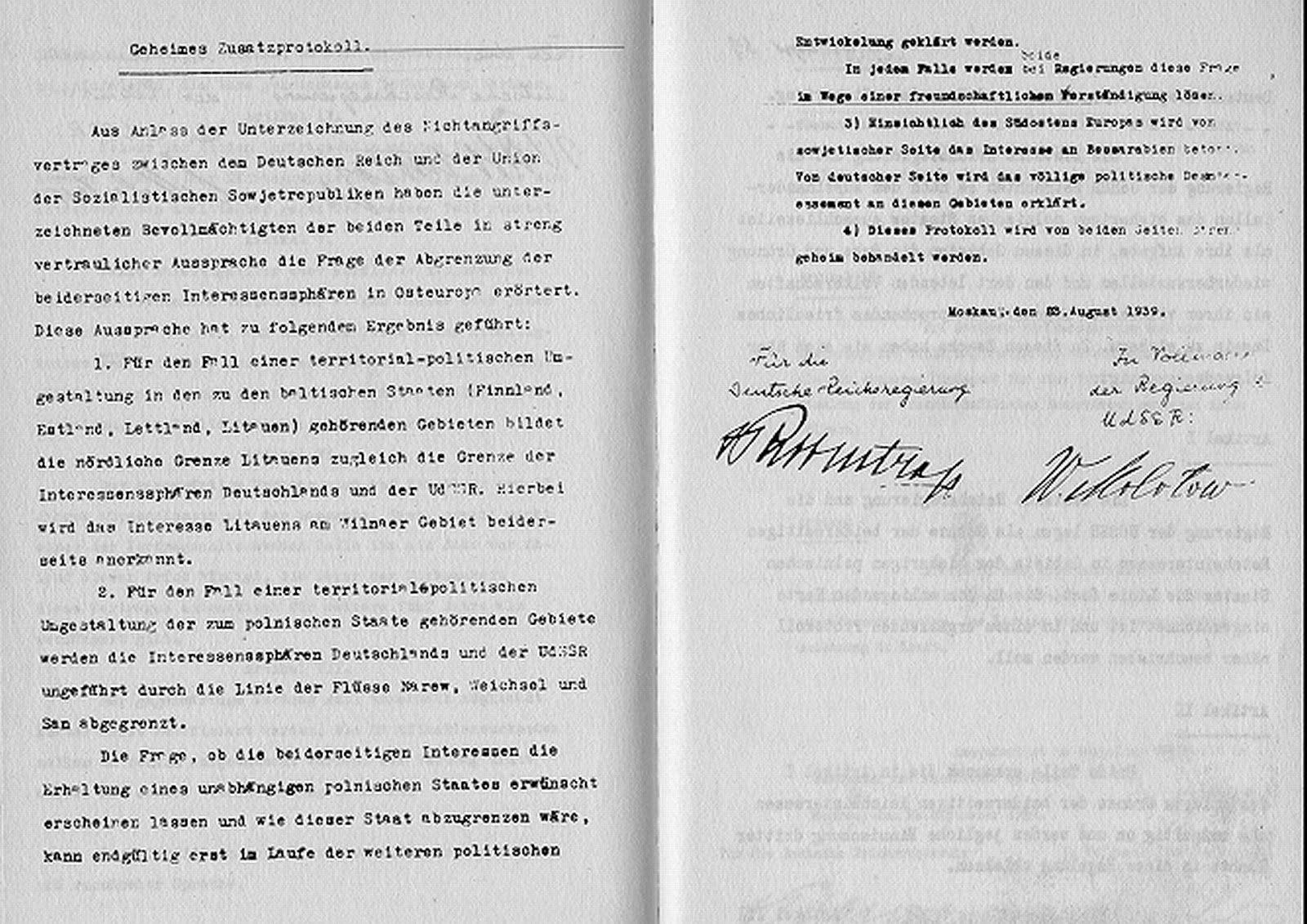On this date, August 23, 1939, Nazi Germany and the Soviet Union sign a non-aggression treaty, the Molotov–Ribbentrop Pact. In a secret addition to the pact, the Baltic states, Finland, Romania, and Poland are divided between the two nations. I will post information about this historical event from Wikipedia and other links.
The Molotov–Ribbentrop Pact, named after the Soviet foreign minister Vyacheslav Molotovand the Nazi German foreign minister Joachim von Ribbentrop, officially the Treaty of Non-aggression between Germany and the Union of Soviet Socialist Republics, and also known as the Ribbentrop–Molotov Pact or Nazi–Soviet Pact, was a non-aggression pact signed in Moscow in the late hours of 23 August 1939.
The pact's publicly stated intentions were a guarantee of non-belligerence by either party towards the other and a commitment that neither party would ally itself to or aid an enemy of the other party. This latter provision ensured that Germany would not support Japan in its undeclared war against the Soviet Union along the Manchurian-Mongolian border, ensuring that the Soviets won the Battles of Khalkhin Gol.
In addition to stipulations of non-aggression, the treaty included a secret protocol that divided territories of Romania, Poland, Lithuania, Latvia, Estonia and Finland into Nazi and Soviet "spheres of influence", anticipating potential "territorial and political rearrangements" of these countries. Thereafter, Germany invadedPolandon 1 September 1939. After the Soviet-Japanese ceasefire agreement took effect on 16 September, Stalin ordered his own invasion of Poland on 17 September. Part of southeastern (Karelia) and Sallaregion in Finland were annexed by the Soviet Union after the Winter War. This was followed by Soviet annexations of Estonia, Latvia, Lithuania, and parts of Romania (Bessarabia, Northern Bukovina and the Hertza region).
The pact remained in force until the German government broke it by invading the Soviet Union on 22 June 1941.
Of the territories of Poland annexed by the Soviet Union between 1939 and 1940, the region around Białystok and a minor part of Galiciaeast of the San river around Przemyśl were the only ones returned to the Polish state at the end of World War II. Of all other territories annexed by the USSR in 1939–40, the ones detached from Finland (Karelia, Petsamo), Estonia (Ingrian area and Petseri County) and Latvia (Abrene) remained part of the Russian Federation, the successor state of the Soviet Union, after 1991. Northern Bukovina, Southern Bessarabia and Hertza remain part of Ukraine.
 |
The picture shows Hitler and Stalin and how they are drinking and cheering and acting all happy together, being the fact that it might have happened after Hitler and Stalin signed the Molotov Ribbentrop Europe treaty. [PHOTO SOURCE: http://www.markville.ss.yrdsb.edu.on.ca/history/genocide/genocide_bloodlands_carolynb.html] |
INTERNET SOURCE: http://en.wikisource.org/wiki/Molotov%E2%80%93Ribbentrop_Pact
The Government of the German Reich and The Government of the Union of Soviet Socialist Republics
Desirous of strengthening the cause of peace between Germany and the U.S.S.R., and proceeding from the fundamental provisions of the Neutrality Agreement concluded in April, 1926 between Germany and the U.S.S.R., have reached the following Agreement:
Article I
Both High Contracting Parties obligate themselves to desist from any act of violence, any aggressive action, and any attack on each other, either individually or jointly with other Powers.
Article II
Should one of the High Contracting Parties become the object of belligerent action by a third Power, the other High Contracting Party shall in no manner lend its support to this third Power.
Article III
The Governments of the two High Contracting Parties shall in the future maintain continual contact with one another for the purpose of consultation in order to exchange information on problems affecting their common interests.
Article IV
Should disputes or conflicts arise between the High Contracting Parties, neither shall participate in any grouping of Powers whatsoever that is directly or indirectly aimed at the other party.
Article V
Should disputes or conflicts arise between the High Contracting Parties over problems of one kind or another, both parties shall settle these disputes or conflicts exclusively through friendly exchange of opinion or, if necessary, through the establishment of arbitration commissions.
Article VI
The present Treaty is concluded for a period of ten years, with the proviso that, in so far as one of the High Contracting Parties does not advance it one year prior to the expiration of this period, the validity of this Treaty shall automatically be extended for another five years.
Article VII
The present treaty shall be ratified within the shortest possible time. The ratifications shall be exchanged in Berlin. The Agreement shall enter into force as soon as it is signed.
Secret Additional Protocol
Article I
In the event of a territorial and political rearrangement in the areas belonging to the Baltic States (Finland, Estonia, Latvia, Lithuania), the northern boundary of Lithuania shall represent the boundary of the spheres of influence of Germany and U.S.S.R. In this connection the interest of Lithuania in the Vilna area is recognized by each party.
Article II
In the event of a territorial and political rearrangement of the areas belonging to the Polish state, the spheres of influence of Germany and the U.S.S.R. shall be bounded approximately by the line of the rivers Narev, Vistula and San.
The question of whether the interests of both parties make desirable the maintenance of an independent Polish state and how such a state should be bounded can only be definitely determined in the course of further political developments.
In any event both governments will resolve this question by means of a friendly agreement.
Article III
With regard to Southeastern Europe attention is called by the Soviet side to its interest in Bessarabia. The German side declares its complete political disinterest in these areas.
Article IV
This protocol shall be treated by both parties as strictly secret.
Moscow, August 23, 1939.
For the Government of the German Reich v. Ribbentrop
Plenipotentiary of the Government of the U.S.S.R. V. Molotov
Microfilm copy of Secret Additional Protocol to Nazi–Soviet Pact


